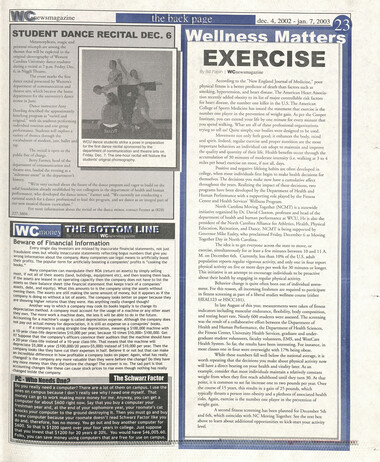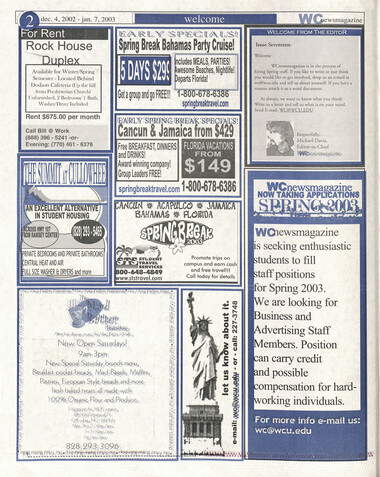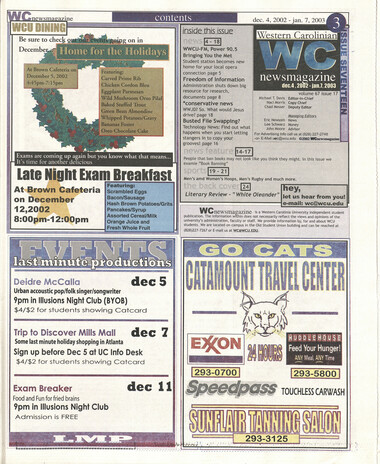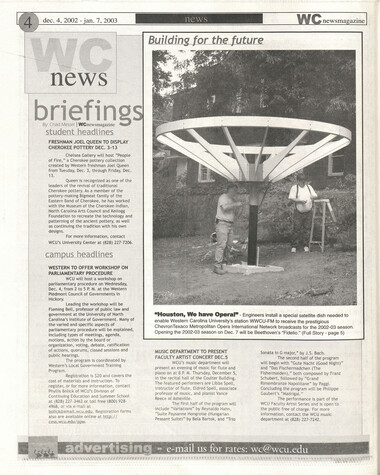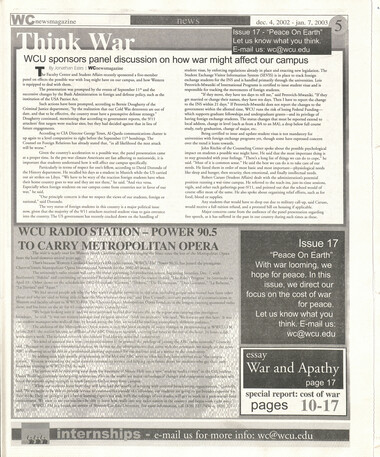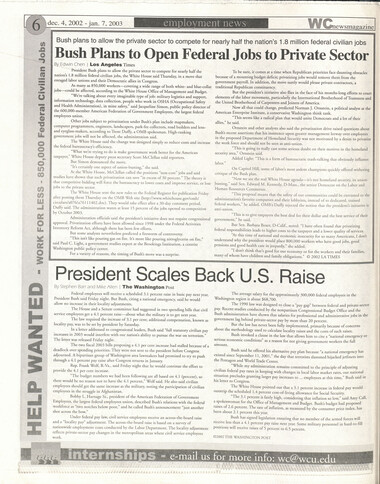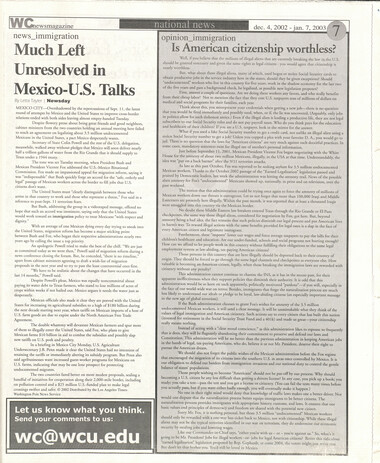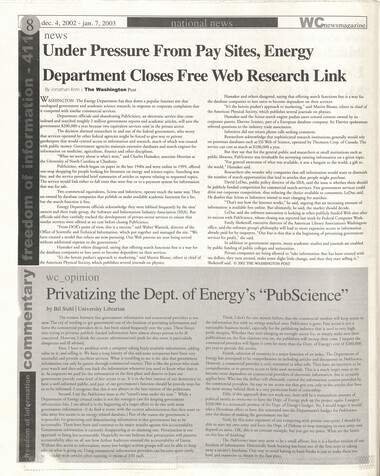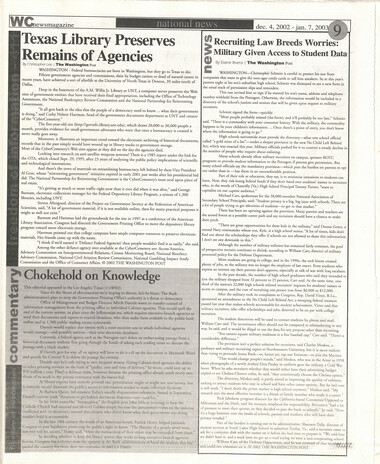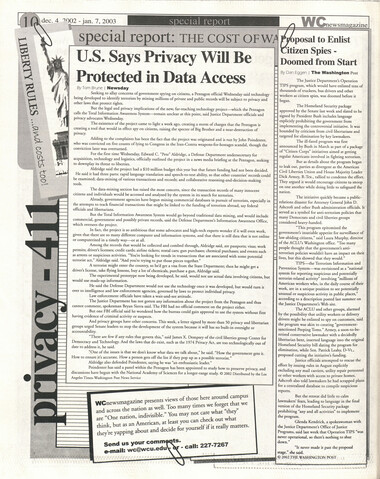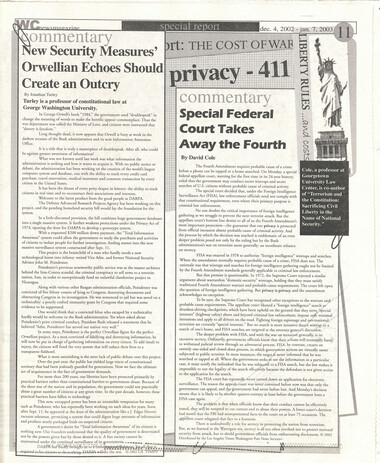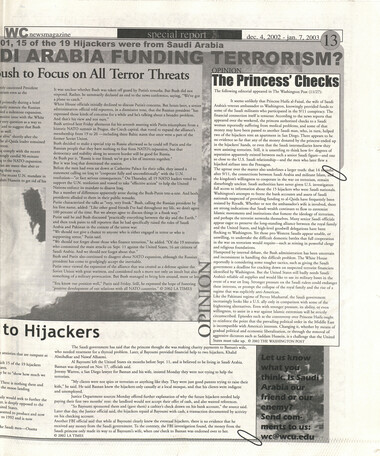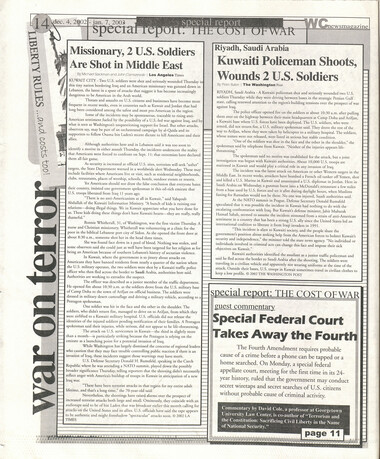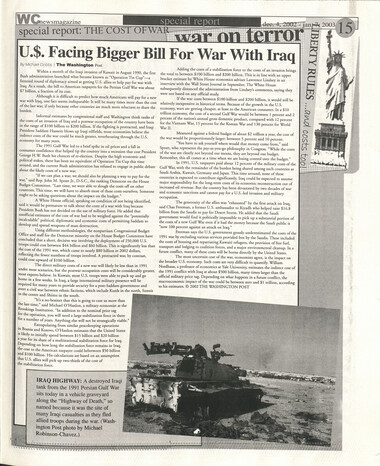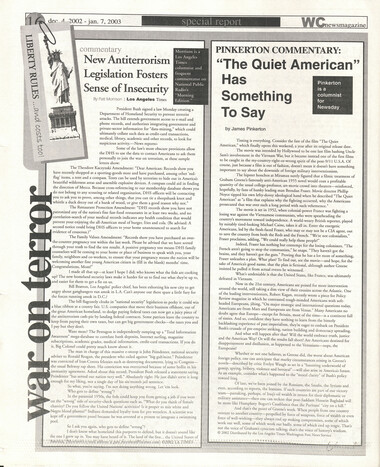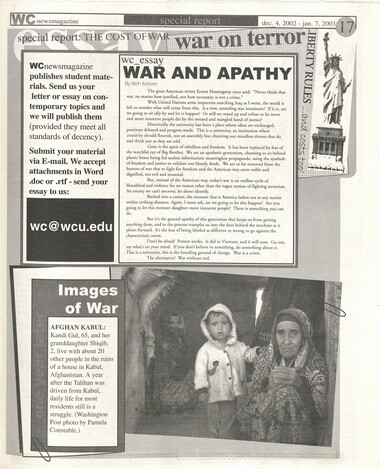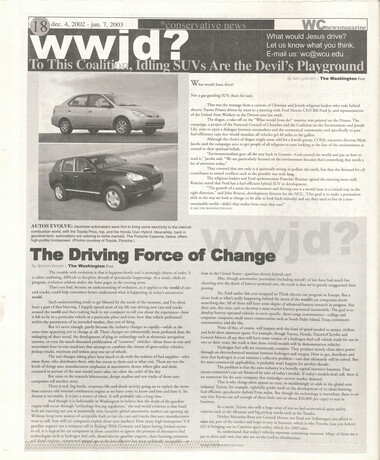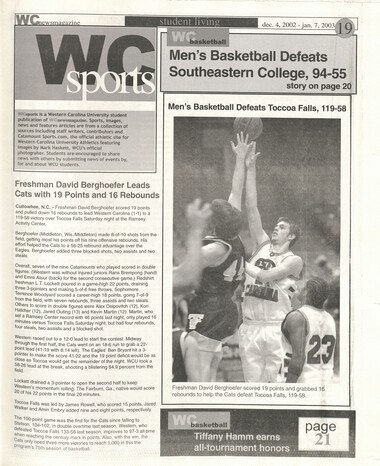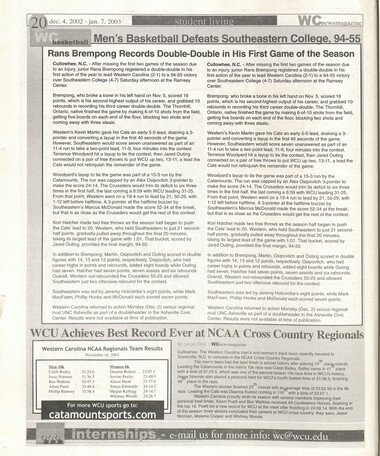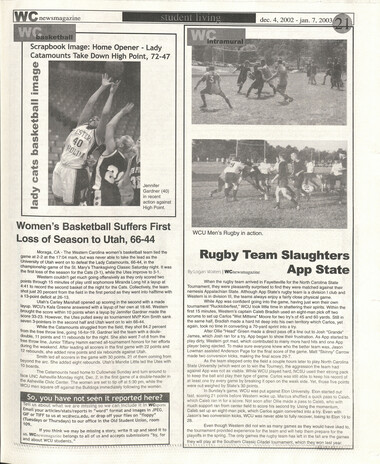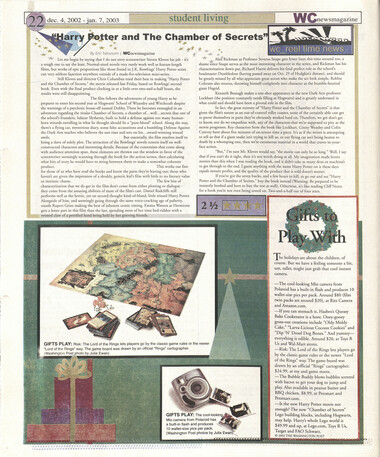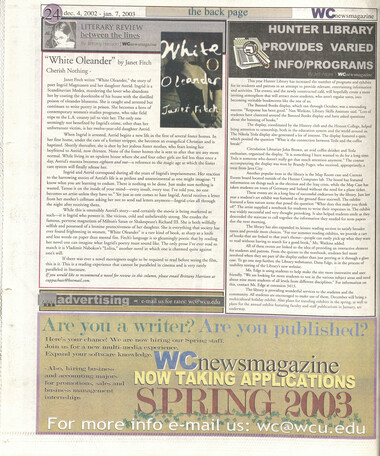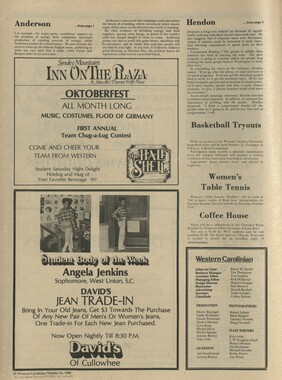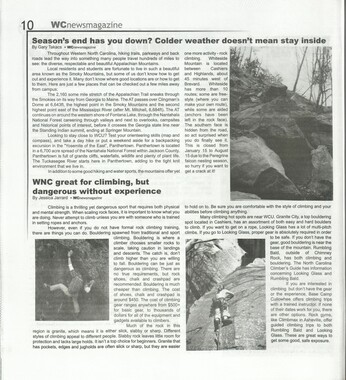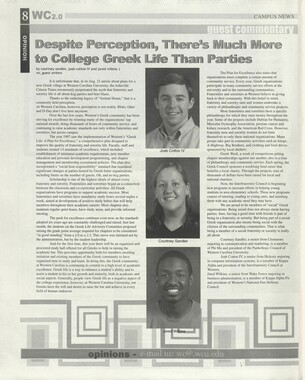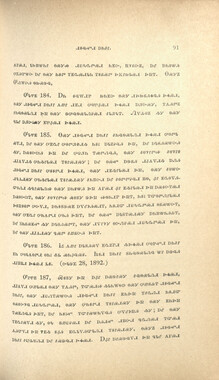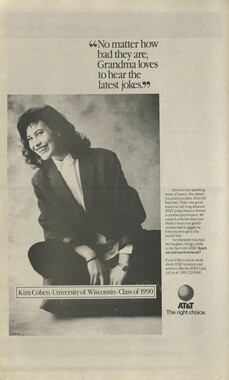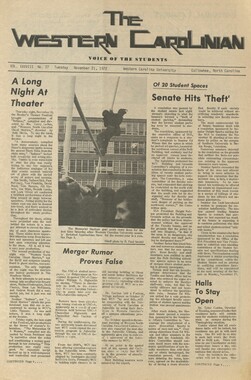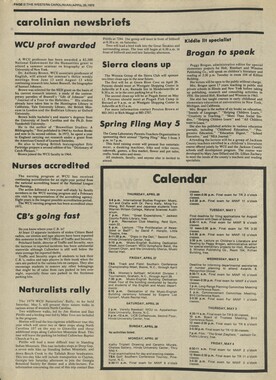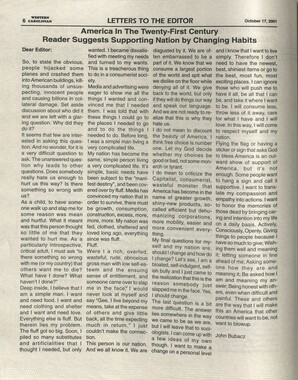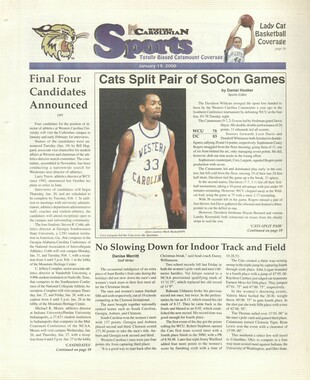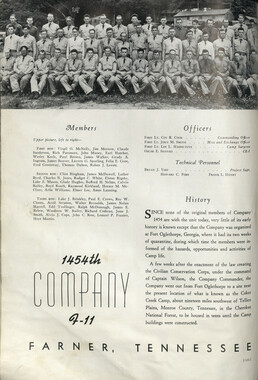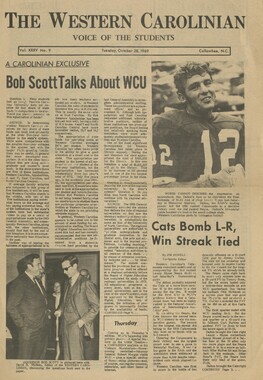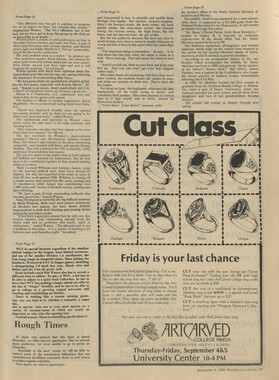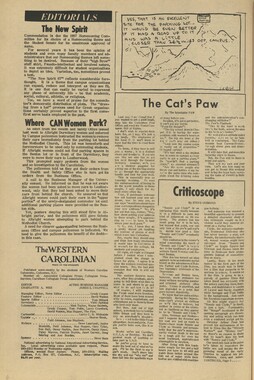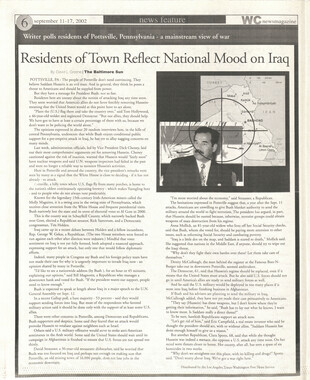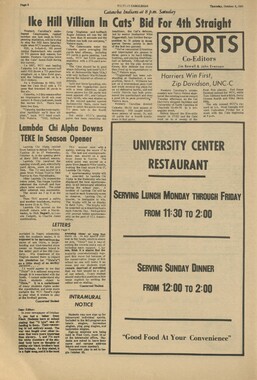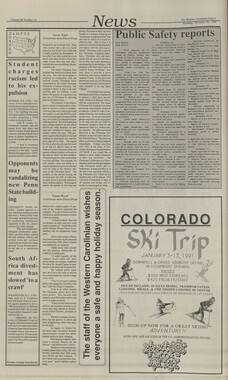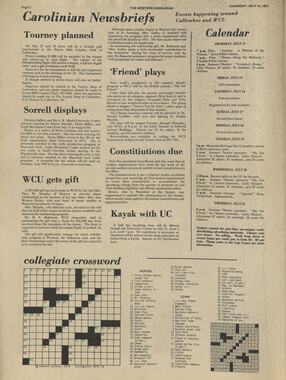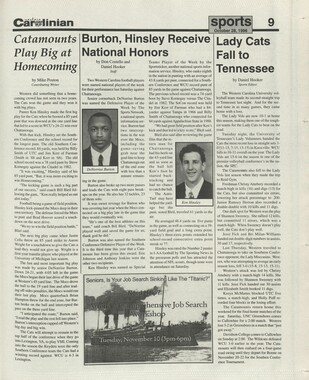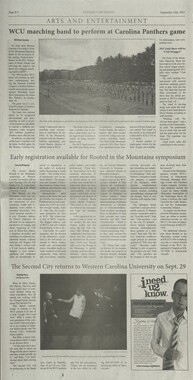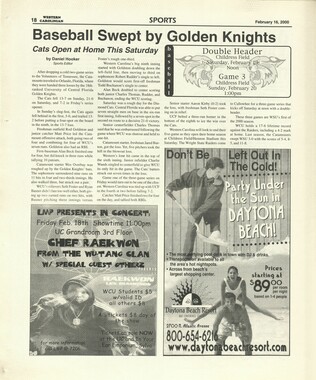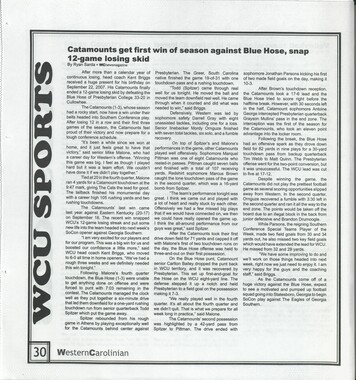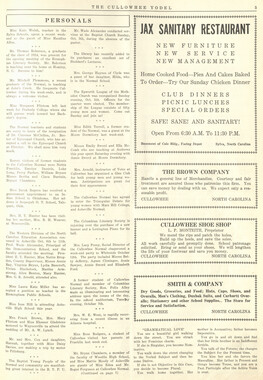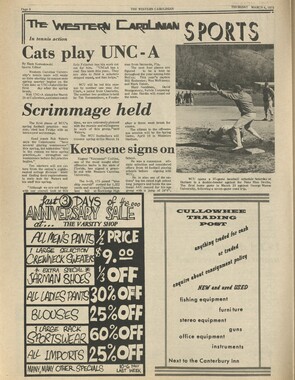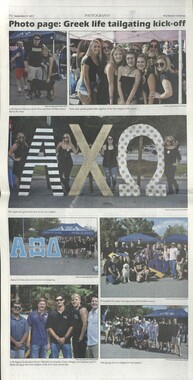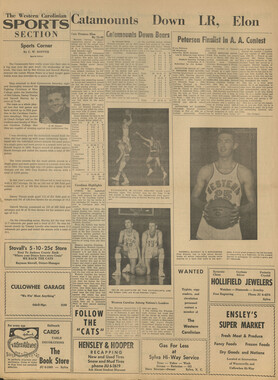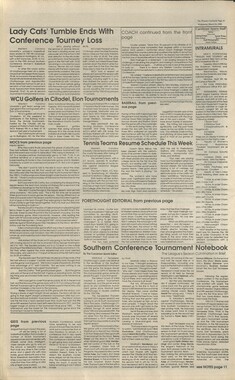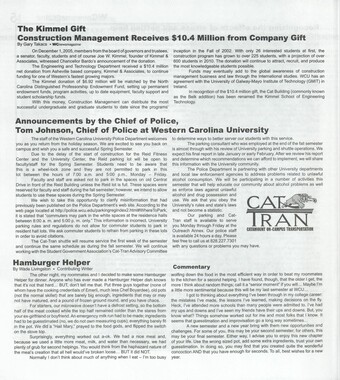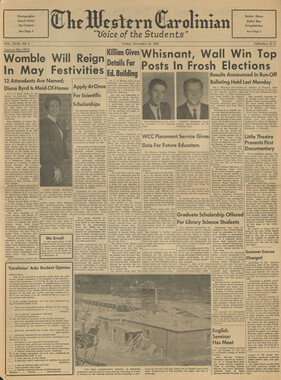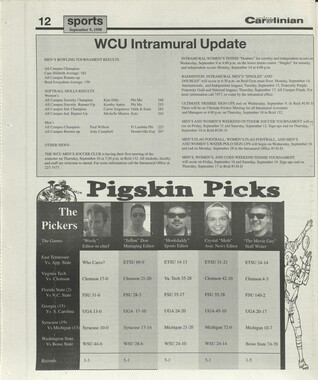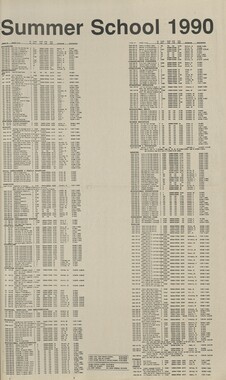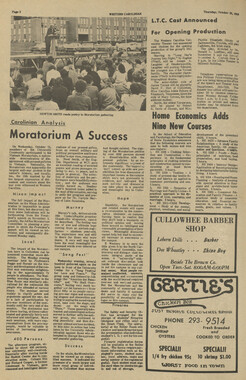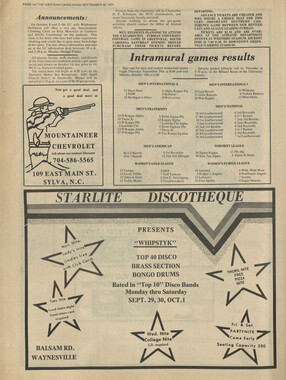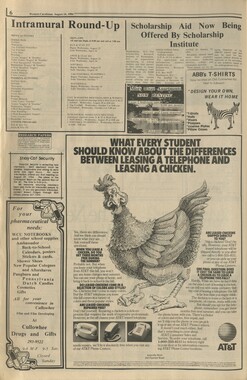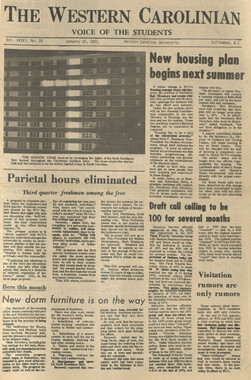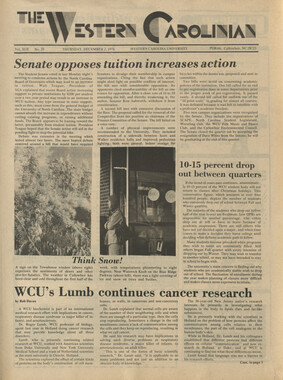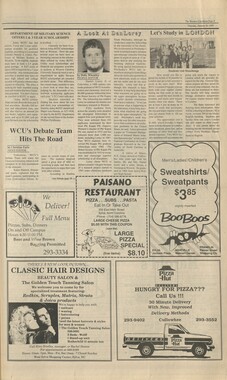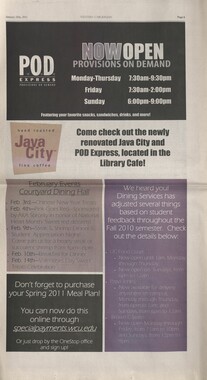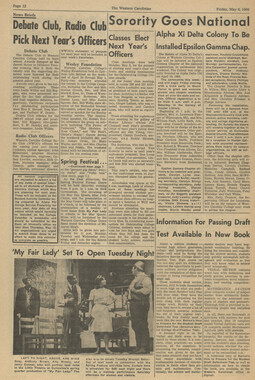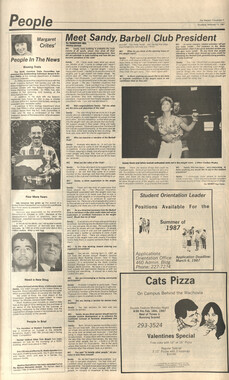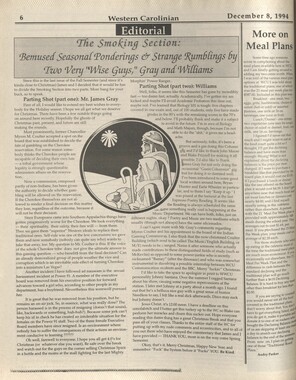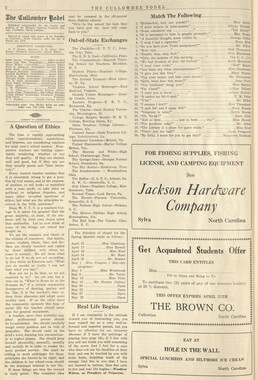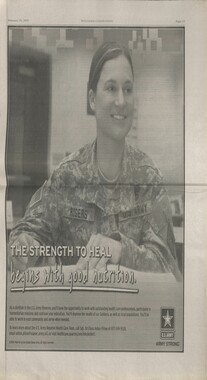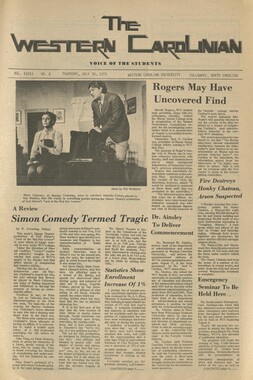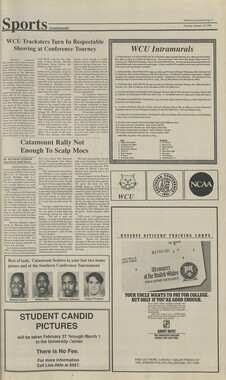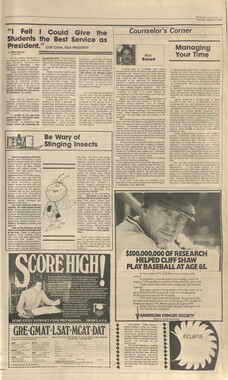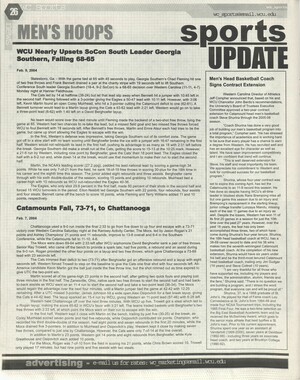Western Carolina University (21)
View all
- Canton Champion Fibre Company (2308)
- Cherokee Traditions (291)
- Civil War in Southern Appalachia (165)
- Craft Revival (1942)
- George Masa Collection (137)
- Great Smoky Mountains - A Park for America (3080)
- Highlights from Western Carolina University (422)
- Horace Kephart (973)
- Journeys Through Jackson (159)
- LGBTQIA+ Archive of Jackson County (89)
- Oral Histories of Western North Carolina (318)
- Picturing Appalachia (6617)
- Stories of Mountain Folk (413)
- Travel Western North Carolina (153)
- Western Carolina University Fine Art Museum Vitreograph Collection (129)
- Western Carolina University Herbarium (92)
- Western Carolina University: Making Memories (738)
- Western Carolina University Publications (2491)
- Western Carolina University Restricted Electronic Theses and Dissertations (146)
- Western North Carolina Regional Maps (71)
- World War II in Southern Appalachia (131)
University of North Carolina Asheville (6)
View all
- Allanstand Cottage Industries (62)
- Appalachian National Park Association (53)
- Bennett, Kelly, 1890-1974 (1463)
- Berry, Walter (76)
- Brasstown Carvers (40)
- Carver, George Washington, 1864?-1943 (26)
- Cathey, Joseph, 1803-1874 (1)
- Champion Fibre Company (233)
- Champion Paper and Fibre Company (297)
- Cherokee Indian Fair Association (16)
- Cherokee Language Program (22)
- Crowe, Amanda (40)
- Edmonston, Thomas Benton, 1842-1907 (7)
- Ensley, A. L. (Abraham Lincoln), 1865-1948 (275)
- Fromer, Irving Rhodes, 1913-1994 (70)
- George Butz (BFS 1907) (46)
- Goodrich, Frances Louisa (120)
- Grant, George Alexander, 1891-1964 (96)
- Heard, Marian Gladys (60)
- Kephart, Calvin, 1883-1969 (15)
- Kephart, Horace, 1862-1931 (313)
- Kephart, Laura, 1862-1954 (67)
- Laney, Gideon Thomas, 1889-1976 (439)
- Masa, George, 1881-1933 (61)
- McElhinney, William Julian, 1896-1953 (44)
- Niggli, Josephina, 1910-1983 (10)
- North Carolina Park Commission (105)
- Osborne, Kezia Stradley (9)
- Owens, Samuel Robert, 1918-1995 (11)
- Penland Weavers and Potters (36)
- Roberts, Vivienne (15)
- Roth, Albert, 1890-1974 (142)
- Schenck, Carl Alwin, 1868-1955 (1)
- Sherrill's Photography Studio (2565)
- Southern Highland Handicraft Guild (127)
- Southern Highlanders, Inc. (71)
- Stalcup, Jesse Bryson (46)
- Stearns, I. K. (213)
- Thompson, James Edward, 1880-1976 (226)
- United States. Indian Arts and Crafts Board (130)
- USFS (683)
- Vance, Zebulon Baird, 1830-1894 (1)
- Weaver, Zebulon, 1872-1948 (58)
- Western Carolina College (230)
- Western Carolina Teachers College (282)
- Western Carolina University (2008)
- Western Carolina University. Mountain Heritage Center (18)
- Whitman, Walt, 1819-1892 (10)
- Wilburn, Hiram Coleman, 1880-1967 (73)
- Williams, Isadora (3)
- Cain, Doreyl Ammons (0)
- Crittenden, Lorraine (0)
- Rhodes, Judy (0)
- Smith, Edward Clark (0)
- Appalachian Region, Southern (3032)
- Asheville (N.C.) (1945)
- Avery County (N.C.) (26)
- Blount County (Tenn.) (195)
- Buncombe County (N.C.) (1680)
- Cherokee County (N.C.) (283)
- Clay County (N.C.) (556)
- Graham County (N.C.) (238)
- Great Smoky Mountains National Park (N.C. and Tenn.) (525)
- Haywood County (N.C.) (3573)
- Henderson County (N.C.) (70)
- Jackson County (N.C.) (4925)
- Knox County (Tenn.) (35)
- Knoxville (Tenn.) (13)
- Lake Santeetlah (N.C.) (10)
- Macon County (N.C.) (421)
- Madison County (N.C.) (216)
- McDowell County (N.C.) (39)
- Mitchell County (N.C.) (135)
- Polk County (N.C.) (35)
- Qualla Boundary (982)
- Rutherford County (N.C.) (78)
- Swain County (N.C.) (2185)
- Transylvania County (N.C.) (270)
- Watauga County (N.C.) (12)
- Waynesville (N.C.) (86)
- Yancey County (N.C.) (72)
- Aerial Photographs (3)
- Aerial Views (60)
- Albums (books) (4)
- Articles (1)
- Artifacts (object Genre) (228)
- Bibliographies (1)
- Biography (general Genre) (2)
- Cards (information Artifacts) (38)
- Clippings (information Artifacts) (192)
- Copybooks (instructional Materials) (3)
- Crafts (art Genres) (622)
- Depictions (visual Works) (21)
- Design Drawings (1)
- Digital Moving Image Formats (2)
- Drawings (visual Works) (185)
- Envelopes (101)
- Exhibitions (events) (1)
- Facsimiles (reproductions) (1)
- Fiction (general Genre) (4)
- Financial Records (12)
- Fliers (printed Matter) (67)
- Glass Plate Negatives (381)
- Guidebooks (2)
- Internegatives (10)
- Interviews (823)
- Land Surveys (102)
- Letters (correspondence) (1045)
- Manuscripts (documents) (618)
- Maps (documents) (177)
- Memorandums (25)
- Minutes (administrative Records) (59)
- Negatives (photographs) (6090)
- Newsletters (1290)
- Newspapers (2)
- Notebooks (8)
- Occupation Currency (1)
- Paintings (visual Works) (1)
- Pen And Ink Drawings (1)
- Periodicals (194)
- Personal Narratives (10)
- Photographs (12977)
- Plans (maps) (1)
- Poetry (6)
- Portraits (4568)
- Postcards (329)
- Programs (documents) (181)
- Publications (documents) (2444)
- Questionnaires (65)
- Relief Prints (26)
- Sayings (literary Genre) (1)
- Scrapbooks (282)
- Sheet Music (2)
- Slides (photographs) (402)
- Songs (musical Compositions) (2)
- Sound Recordings (802)
- Specimens (92)
- Speeches (documents) (18)
- Tintypes (photographs) (8)
- Transcripts (329)
- Text Messages (0)
- A.L. Ensley Collection (275)
- Appalachian Industrial School Records (7)
- Appalachian National Park Association Records (336)
- Axley-Meroney Collection (2)
- Bayard Wootten Photograph Collection (20)
- Bethel Rural Community Organization Collection (7)
- Blumer Collection (5)
- C.W. Slagle Collection (20)
- Canton Area Historical Museum (2110)
- Carlos C. Campbell Collection (462)
- Cataloochee History Project (64)
- Cherokee Studies Collection (4)
- Daisy Dame Photograph Album (5)
- Daniel Boone VI Collection (1)
- Doris Ulmann Photograph Collection (112)
- Elizabeth H. Lasley Collection (1)
- Elizabeth Woolworth Szold Fleharty Collection (4)
- Frank Fry Collection (95)
- George Masa Collection (173)
- Gideon Laney Collection (452)
- Hazel Scarborough Collection (2)
- Hiram C. Wilburn Papers (28)
- Historic Photographs Collection (236)
- Horace Kephart Collection (861)
- Humbard Collection (33)
- Hunter and Weaver Families Collection (1)
- I. D. Blumenthal Collection (4)
- Isadora Williams Collection (4)
- Jesse Bryson Stalcup Collection (47)
- Jim Thompson Collection (224)
- John B. Battle Collection (7)
- John C. Campbell Folk School Records (80)
- John Parris Collection (6)
- Judaculla Rock project (2)
- Kelly Bennett Collection (1482)
- Love Family Papers (11)
- Major Wiley Parris Civil War Letters (3)
- Map Collection (12)
- McFee-Misemer Civil War Letters (34)
- Mountain Heritage Center Collection (4)
- Norburn - Robertson - Thomson Families Collection (44)
- Pauline Hood Collection (7)
- Pre-Guild Collection (2)
- Qualla Arts and Crafts Mutual Collection (12)
- R.A. Romanes Collection (681)
- Rosser H. Taylor Collection (1)
- Samuel Robert Owens Collection (94)
- Sara Madison Collection (144)
- Sherrill Studio Photo Collection (2558)
- Smoky Mountains Hiking Club Collection (616)
- Stories of Mountain Folk - Radio Programs (374)
- The Reporter, Western Carolina University (510)
- Venoy and Elizabeth Reed Collection (16)
- WCU Gender and Sexuality Oral History Project (36)
- WCU Mountain Heritage Center Oral Histories (25)
- WCU Oral History Collection - Mountain People, Mountain Lives (71)
- WCU Students Newspapers Collection (1923)
- Western North Carolina Tomorrow Black Oral History Project (69)
- William Williams Stringfield Collection (2)
- Zebulon Weaver Collection (109)
- African Americans (390)
- Appalachian Trail (35)
- Artisans (521)
- Cherokee art (84)
- Cherokee artists -- North Carolina (10)
- Cherokee language (21)
- Cherokee pottery (101)
- Cherokee women (208)
- Church buildings (190)
- Civilian Conservation Corps (U.S.) (111)
- College student newspapers and periodicals (2012)
- Dams (108)
- Dance (1023)
- Education (222)
- Floods (63)
- Folk music (1015)
- Forced removal, 1813-1903 (2)
- Forest conservation (220)
- Forests and forestry (1198)
- Gender nonconformity (4)
- Great Smoky Mountains National Park (N.C. and Tenn.) (181)
- Hunting (47)
- Landscape photography (25)
- Logging (122)
- Maps (83)
- Mines and mineral resources (9)
- North Carolina -- Maps (18)
- Paper industry (38)
- Postcards (255)
- Pottery (135)
- Railroad trains (72)
- Rural electrification -- North Carolina, Western (3)
- School integration -- Southern States (2)
- Segregation -- North Carolina, Western (5)
- Slavery (5)
- Sports (452)
- Storytelling (243)
- Waterfalls -- Great Smoky Mountains (N.C. and Tenn.) (66)
- Weaving -- Appalachian Region, Southern (280)
- Wood-carving -- Appalachian Region, Southern (328)
- World War, 1939-1945 (173)
Western Carolinian Volume 67 Number 17
Item
Item’s are ‘child’ level descriptions to ‘parent’ objects, (e.g. one page of a whole book).
-
-
ewsmagazine the back page dec. 4, 2002 -jan. 7, 2003 STUDENT DANCE RECITAL DECE 6 Cafo:lina Unive±sity. dance studentg:t NiggliThéätrel Theovent.måf:ké the fifSt datiC&.reCital preS&ited by Western?s: Of communication and. theat!é arts, Which became%the home. dépaifmen•t dance, .Dånce:instructorAmy. DosOling described the approximafély: hou:tlong. program åS.. * variéd: and with performing: roudines and one group performance3Studé1its will: explore a Nariety.OfiÉhenieS through the vocabularies of:modern, j ballet: •and (tap, Theåeéital iS• open the -Public: free of?chargei Betty Farmers head ofthe and attss lauded the. evening as in the department?s: WCU dance students strike a pose in preparation for the first dance recital sponsored by the department of communication and theatre arts on Friday, Dec. 7. The one-hour recital will feature the students' original choreography. e We're: very excited about the future ofthé dance program andeagetto •build on che •Solid foundation already: established by: human who developed. thé dance Farmer. Conducting:.å tha:tiOnal search for a:dance, professional. -to: leåd progrÅm, and See, dance: as musical theatre.eurrieulume: For more informatiotüabout thefecitål .0f: the' dance minor; •ontåct• 22%3804€ By: Lee SCtlWåiz l) WCnewsmagaiine Beware of Financial Information Every single day investors are mislead by inaccurate financial statements, not just fraudulent ones but wholly innaccurate statements reflecting bogus numbers that give you wrong information about the company. Many companies use legal means to artificially boost their profits. The popular term for artificially boosting a companies' profits is "cooking the books. " Many companies can manipulate their ROA (return on assets) by simply selling most, if not all of their assets (land, bulidings, equiptment etc), and then leasing them back. If the assets are leased in an operating capacity then the company does not have to list the assets on their balance sheet (the financial statement that keeps track of a companies' assets, debt, and equity). What this amounts to is the company using the assets without owning them. The assets are still making the same amount of money, but it appears as if the company is doing so without a lot of assets. The company looks better on paper because they are showing higher returns than they were. Has anything really changed though? Another way in which a company may cook its books legally is to change its depreciation method. A company must account for the usage of a machine or any other asset they own. The more work a machine does, the less it will be able to do in the future. Accounting for a machine's usage is called depreciation expense. Although the company does not pay out actual money for depreciation, it is still an expense on a comapnies' books. If a company is using straight-line depreciation, meaning a $100,000 machine with a 10-year class-life depreciates $10,000 per year, because 10 times $100,000. Get it? Suppose that the company's officers convince their auditors that the machine should have a 20-year class-life instead of a 10-year class-life. That means that the machine will depreciate $5,000 a year ($100,000/20 years=$5,000) instead of $10,000 per year. Then the Company looks like they have cut their expenses in half. Believe it or not but that can make an incredible difference in how profitable a company looks on paper. Again, what has really changed? Is the company any more valuable than they were before the change? Do they have any more money than they did before the change? The answer is no. The sad part is that accounting changes like these can cause stock prices to rise even though nothing has really changed inside the company. PC Who Needs OneP The Schwarz Factor DO you really need a computer? There are a lot of them on campus. N use the ones On campus because I don't really see why I need one myself. That money can go to work making more money for me. Ahywayj you can get a COmputer for about $600 right now. Say that you buy a computer your freshman year and, at the end of your sophomore year, your roomate's cat knocks your computer to the ground destroying it. Then you must go and buy a new computer because your roomate doesn't read Schwarz Factor like you do and, thereforey has no money. You go out and buy another computer for $600. So that is $ i 200 spent over your four years in college. Just suppose that you invest that $1200 for 20 years @ 20%. You would have $46,005.60. Folks, you can save money using computers that are free for use On campus. EXERCISE By Bill Papin I WCnewsmagazine According to the "New England Journal of Medicine, " poor physical fitness is a better predictor of death than factors such as smoking, hypertension, and heart disease. The American Heart Associa- tion recently added obesity to its list of major controllable risk factors for heart disease, the number one killer in the U.S. The American College of Sports Medicine has issued the statement that exercise is the number one player in the prevention of weight gain. As per the Cooper Institute, you can extend your life by one minute for every minute that you spend walking. What are all of these professional organizations trying to tell us? Quite simply, our bodies were designed to be used. Movement not only feels good; it enhances the body, mind and spirit. Indeed, regular exercise and proper nutrition are the most important behaviors an individual can adopt to maintain and improve the quality and quantity of their life. Health benefits occur through the accumulation of 30 minutes of moderate intensity (i.e. walking at 3 to 4 miles per hour) exercise on most, if not all, days. Positive and negative lifelong habits are often developed in college, when most individuals first begin to make health decisions for themselves. The decisions you make now have a cumulative affect throughout the years. Realizing the impact of these decisions, two programs have been developed by the Department of Health and Human Performance with a supporting role played by the Fitness Center and Health Services' Wellness Program. North Carolina Moving Together (NCMT) is a statewide initiative organized by Dr. David Claxton, professor and head of the department of health and human performance at WCU. He is also the president of the North Carolina Alliance for Athletics, Health, Physical Education, Recreation, and Dance. NCMT is being supported by Governor Mike Easley, who proclaimed Friday, December 6 as Moving Together Day in North Carolina. The idea is to get everyone across the state to move, or exercise, simultaneously for at least a few minutes between 10 and 1 1 A. M. on December 6th. Currently, less than 10% of the U.S. adult population reports regular vigorous activity, and only one in four report physical activity on five or more days per week for 30 minutes or longer. This initiative is an attempt to encourage individuals to be proactive about their health by engaging in regular physical activity. Behavior change is quite often born out of individual assess- ment. For this reason, all incoming freshmen are required to participate in fitness screening as part of a liberal studies wellness course (either HEAL123 or HSCCIOI). In late August of this year, measurements were taken of fitness indicators including muscular endurance, flexibility, body composition, and resting heart rate. Nearly 600 students were assessed. The screening was the result of a collaborative effort between the Department of Health and Human Performance, the Department of Health Sciences, the Fitness Center, University Health Services, graduate and under- graduate student volunteers, faculty volunteers, EMS, and WestCare Health System. So far, the results have been interesting. For instance, in most classes one in four were overweight with 17% being obese. While these numbers fall well below the national average, it is worth repeating that the decisions you make about physical activity now will have a direct bearing on your health and vitality later. As an example, consider that most individuals maintain a relatively constant weight from when they first reach adulthood until they turn 30. At that point, it is common to see fat increase one to two pounds per year. Over the course of 15 years, this results in a gain of 25 pounds, which typically thrusts a person into obesity and a plethora of associated health risks. Again, exercise is the number one player in the prevention of weight gain. A second fitness screening has been planned for December 5th and 6th, which coincides with NC Moving Together. See the text box above to learn about additional opportunities to kick-start your activity level.
Object
Object’s are ‘parent’ level descriptions to ‘children’ items, (e.g. a book with pages).
-
The Western Carolinian is Western Carolina University's student-run newspaper. The paper was published as the Cullowhee Yodel from 1924 to 1931 before changing its name to The Western Carolinian in 1933.
-
